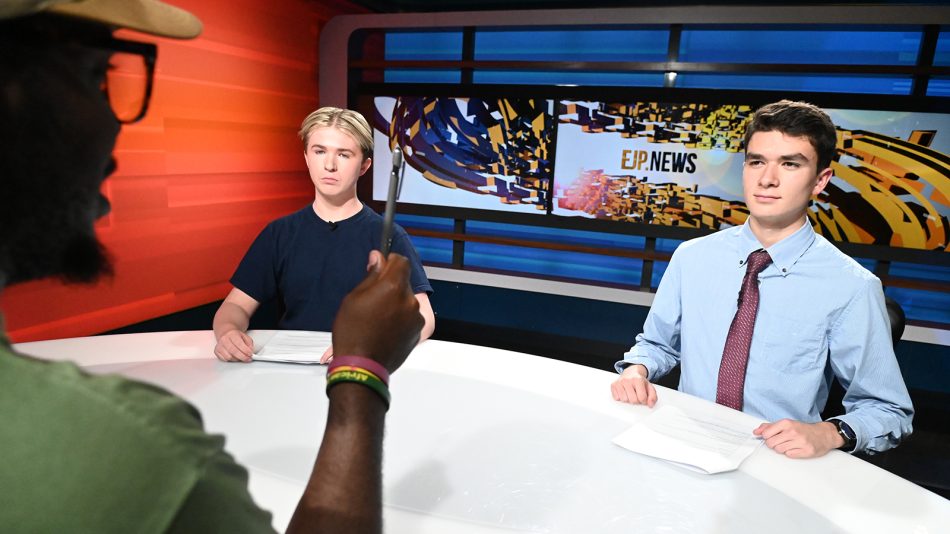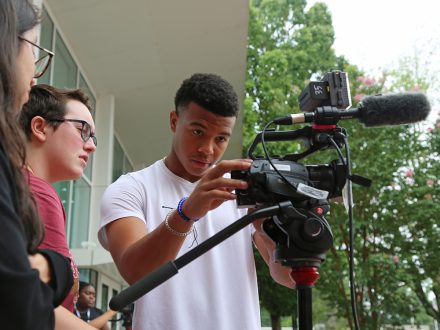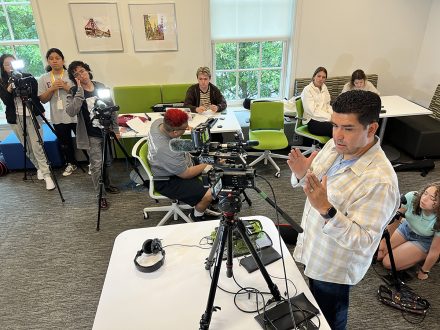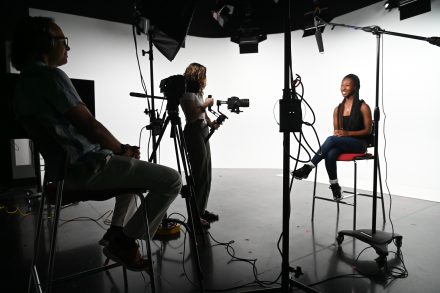The 12-day residential journalism workshop, made possible through $300,000 in grant funding from the Scripps Howard Fund, welcomed high school students from across the country to Elon University’s campus for an in-depth dive into journalism, communications and media.

The feverish pace of the Emerging Journalists Program’s 12-day Immersion experience this summer began on the first night as the 20 high school students – hailing from 11 states – received their initial story assignments.
While the rising seniors in the cohort all have an interest in journalism, their formal writing and reporting backgrounds varied greatly, including a few with no prior experience at all. Nevertheless, the students were tasked with producing a broadcast news show, newspaper and website during their time on campus, as well as balancing an itinerary jam-packed with company visits to WXII 12 News in Winston-Salem and Trailblazer Studios in Raleigh, as well as an interview with state Rep. Reneé Price at the North Carolina State Capitol.

Photos of the EJP Immersion experience are available on the school’s Flickr account.
A generous $300,000 grant from the Scripps Howard Fund financially supports the program, which helps students develop and enhance their skills in reporting, writing, multimedia storytelling, leadership and media management. The initiative’s overarching objective is to provide students with the ideal platform to explore their communications interests.
“All of the Emerging Journalists Program, but especially the Immersion experience, is designed to inspire high school students to think about what a career in journalism might look like,” said Senior Lecturer in Journalism Kelly Furnas, who serves as EJP’s curriculum coordinator.
And the best way to learn is to do, especially under the mentorship and hands-on instruction of School of Communications faculty and staff.
“EJP is a case study in tenacity and teamwork, chemistry and connectedness,” said Instructor of Journalism Colin Donohue, who oversees the summer program’s logistics. “There’s something magical about watching a group of 20 students from throughout the United States who don’t know each other bond almost instantly and then get to work on reporting and writing. We put their feet to the fire immediately, and the easy response would be to wilt from the heat. But these students instead stood tall and got to work. It was thrilling and inspiring.”
Envisioning their future
While touring the WXII 12 News broadcast studios on June 24 with her fellow Immersion cohort members, Kate Gray witnessed the WXII staff preparing for that evening’s broadcast and could envision the facilities’ energetic pace when recording live.
The high schooler from Silver Spring, Maryland, has long had an interest in writing and communications, and recently completed an award-winning documentary, but touring the NBC affiliate opened her mind up to other possibilities.
“When we were touring, they weren’t doing an actual broadcast, but I could see in my head how it would look with everyone there working together,” Gray said. “That was when I realized I might want to do broadcast.”

Four days later, Gray sat at the anchor desk in Elon’s Jane and Brian Williams Studio, getting broadcast reps of her own while working with her fellow students who were overseeing the control room, manning the cameras, and working the teleprompter.
Gray’s experience of seeing and then doing encapsulates the EJP experience, and what students encounter at the School of Communications, Donohue explained.
“We hope EJP gives students interested in journalism the chance to learn how to report and write, particularly if they don’t have that opportunity in high school,” he said. “We want to expose them to the craft of journalism but also allow them to see the many possibilities open to them in the larger field of communications. And in the end, we hope they realize they have the potential to tell important stories that impact their community.”
The program is designed to educate students from diverse socio-economic, racial and ethnic backgrounds, building on the collective commitment of Scripps Howard and Elon to advance equity, diversity and inclusion in communications industries. In addition to producing their own stories and broadcast packages, the students participated in numerous classes and workshops on topics such as photography, lightning and audio, and the Adobe Creative Suite. Additionally, instructors helped students create a professional LinkedIn profile and discussed how to best navigate the college application and financial aid processes.

Furnas said there is immense value in providing students with hands-on, experiential learning opportunities where they have access to professional-grade equipment and facilities, while also interacting regularly with college students, school instructors and media professionals. “And, perhaps most importantly, they are able to work alongside their peers from across the country,” he added.
This combination leads to exponential growth over the course of the 12-day program. The cohort’s media visits – like WXII 12 News and Trailblazer Studios – add additional perspective beyond the hard skills needed to excel professionally.
“The Elon alumni and other professionals at WXII 12 and at Trailblazer Studios were incredibly generous with their time and energy,” Furnas said. “The facilities were fascinating and top-notch, but I think the experience made our students realize that communications is a team sport. Both of these companies highlighted how having the latest tools and technology might be eye-catching, but having the right culture actually makes the profession worthwhile and enjoyable.”
Another noteworthy student experience included pitching story ideas to writers and editors at The New York Times. Elon alumna Natalie Green ’21, a client coordinator of public policy for the prominent news outlet, helped organize the virtual session, during which students proposed a story they’d like to pursue back home. The Times staff offered the students thoughtful feedback that centered on sourcing, research, angles and story development.
“The Times’ folks were effusive in their praise of the work the students had done, and they want to see the work they ultimately produce over the next year,” Donohue said. “The students were awestruck that they received direct and immediate direction from people working at the top of the journalism industry.”
Furnas commended this year’s cohort for its effort, willingness to collaborate, and remarkable curiosity, noting how students often peppered lecturers with question after question. “That desire for information — and the unabashed ability to seek it — will serve these students remarkably well in their storytelling careers,” he said.
Succeeding together
Miles Hayter, who hails from Potomac, Maryland, noted that he had never visited a college campus before he applied for EJP’s Immersion experience. And the prospect of working with university professors, surrounded by unfamiliar peers, seemed daunting at first. Yet, he said he was met with support and warmth that he will long remember.

“I have gained a lot of close friends and relationships during our time together. And those will continue, and that is extremely meaningful to me,” he said. “While I initially came to Elon to study journalism, I made real friendships as well.”
Thanks to his relationships with peers, professors and counselors, as well as the company visits with Elon alumni, Hayter said he more clearly sees his path to working professionally in social media, marketing and communications.
“I am in awe of what can be and what I can possibly do,” he said. “What I have seen around me, what I have been shown, has been really inspiring.”
Despite nearly two full weeks of conducting numerous interviews, shooting video, taking photos and writing stories, the students’ enthusiasm never wavered – in fact, it grew, marveled Donohue.
“This year’s group exhibited tremendous perseverance,” he said. “Most of them came to Elon without any formal journalism education or experience, so the task of creating a newspaper, newscast and website was certainly a tall one. But it seemed like they gained energy with every passing day, as they struggled together, toiled together, and ultimately succeeded together. I was struck that when the deadlines rapidly approached, they exhibited tremendous resolve and focus. They should be proud of what they accomplished.”
About the Scripps Howard Fund
The Scripps Howard Fund supports philanthropic causes important to The E.W. Scripps Company and the communities it serves, with a special emphasis on journalism education, excellence in journalism and childhood literacy. At the crossroads of the classroom and the newsroom, the fund is a leader in supporting journalism education, scholarships, internships, minority recruitment and development and First Amendment causes.


